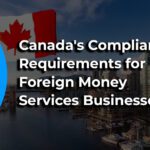
Global AML Trends to Watch in 2025: What Compliance Professionals Need to Know
March 25, 2025
Canada’s Compliance Requirements for Foreign Money Services Businesses
April 2, 2025The Financial Transactions and Reports Analysis Centre of Canada (FINTRAC) plays a critical role in enforcing Anti-Money Laundering (AML) and Counter-Terrorist Financing (CTF) regulations. Businesses subject to the Proceeds of Crime (Money Laundering) and Terrorist Financing Act (PCMLTFA) must undergo periodic FINTRAC audits to ensure compliance. In 2025, audit expectations are more stringent than ever, requiring businesses to be well-prepared.
To navigate these heightened requirements effectively, it’s essential to stay informed about FINTRAC’s latest AML directives and their impact on Canadian MSBs and PSPs. Learn how your business can adapt and maintain compliance in our latest article: FINTRAC’s Latest AML Directives: How Canadian MSBs and PSPs Should Prepare. Stay ahead of regulatory changes before diving into our insights on audit readiness.
Understanding FINTRAC Audits
A FINTRAC audit assesses whether a business is adhering to AML and CTF regulations. The review process involves:
- Evaluating policies and procedures.
- Checking record-keeping and reporting compliance.
- Assessing risk management frameworks.
- Reviewing customer due diligence (CDD) and Know Your Customer (KYC) processes.
Failure to meet compliance requirements can result in significant penalties, reputational damage, and even legal action.
Key Compliance Requirements
To pass a FINTRAC audit in 2025, businesses must ensure compliance with:
- Risk-Based Approach (RBA): Companies must assess and categorize customers based on risk levels and apply enhanced due diligence (EDD) for high-risk clients.
- Record-Keeping: Maintain detailed transaction records for a minimum of five years.
- Reporting Obligations: Submit Suspicious Transaction Reports (STRs), Large Cash Transaction Reports (LCTRs), and Electronic Funds Transfer Reports (EFTRs) as required.
- AML Training: Regularly train employees on compliance policies and FINTRAC expectations.
- Independent Compliance Review: Conduct periodic internal audits to identify and correct deficiencies.
Step-by-Step Audit Preparation Guide
1. Conduct an Internal Compliance Review
- Evaluate existing AML policies and update them to align with regulatory changes.
- Assess previous audit findings and address any unresolved issues.
2. Ensure Proper Record-Keeping
- Verify that all required transaction records are stored securely and are easily accessible.
- Organize KYC documentation for all customers, including identity verification records.
- Ensure that STRs, LCTRs, and EFTRs have been correctly submitted within required timelines.
- Validate that reporting thresholds are consistently applied.
4. Test Your Risk-Based Approach (RBA)
- Confirm that risk assessments align with FINTRAC’s guidelines.
- Check whether high-risk customers have undergone enhanced due diligence (EDD).
5. Train Staff on Compliance Procedures
- Conduct refresher training sessions to reinforce AML compliance awareness. Regular training ensures that employees stay updated on evolving regulations and best practices, reducing the risk of non-compliance. Explore our compliance training solutions to strengthen your team’s AML competence and regulatory readiness.
- Document training completion to demonstrate adherence to regulatory requirements.
6. Conduct a Mock Audit
- Simulate an audit scenario by having an independent review of your compliance program.
- Identify weaknesses and take corrective actions before the official audit.
Common Audit Pitfalls to Avoid
- Incomplete or Inaccurate Records: Missing documents or incorrect filings can lead to compliance failures.
- Failure to Submit Required Reports: Late or missing STRs, LCTRs, or EFTRs can result in penalties.
- Inconsistent Application of Policies: Lack of uniform adherence to AML procedures across departments.
- Lack of Staff Training: Employees unaware of compliance obligations pose a significant risk.
Best Practices for a Successful Audit
- Stay Informed: Keep up with FINTRAC updates and regulatory changes.Explore our compliance training solutions to strengthen your team’s AML competence and regulatory readiness.
- Automate Compliance Processes: Use compliance software to streamline transaction monitoring and reporting.
- Engage a Compliance Consultant: Conduct refresher training sessions to reinforce AML compliance awareness. Regular training ensures that employees stay updated on evolving regulations and best practices, reducing the risk of non-compliance. Get in touch with our compliance experts today and ensure your organization remains fully compliant.
- Maintain Open Communication with FINTRAC: Respond promptly and transparently to audit inquiries.
Conclusion
Preparing for a FINTRAC audit in 2025 requires proactive planning, robust record-keeping, and ongoing staff training. By implementing a strong compliance program, businesses can ensure a smooth audit process, avoid costly penalties, and maintain regulatory trust.
For expert compliance guidance, partner with Paycompliance today and ensure your business is audit-ready.
Sources:



